Measurement of Muon Antineutrino Oscillations with an Accelerator-Produced Off-Axis Beam
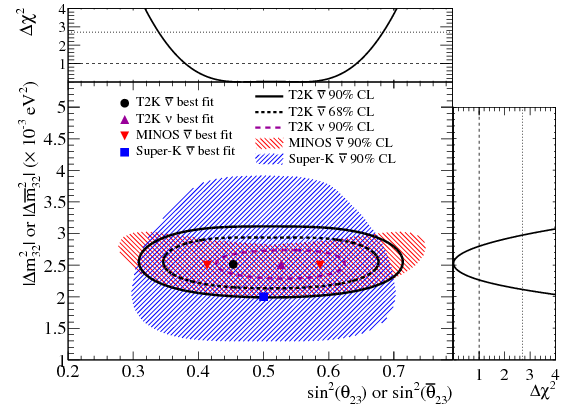
T2K reports its first measurements of the parameters governing the disappearance of ν̅μ in an off-axis beam due to flavor change induced by neutrino oscillations. The quasimonochromatic ν̅μ beam, produced with a peak energy of 0.6 GeV at J-PARC, is observed at the far detector Super-Kamiokande, 295 km away, where the ν̅μ survival probability is expected to be minimal. Using a data set corresponding to 4.01×1020 protons on target, 34 fully contained μ-like events were observed. The best-fit oscillation parameters are sin2(θ̅23)=0.45 and |Δm̅232|=2.51×10−3 eV2 with 68% confidence intervals of 0.38–0.64 and 2.26–2.80×10−3 eV2, respectively. These results are in agreement with existing antineutrino parameter measurements and also with the νμ disappearance parameters measured by T2K.
Measurements of neutrino oscillation in appearance and disappearance channels by the T2K experiment with 6.6E20 protons on target
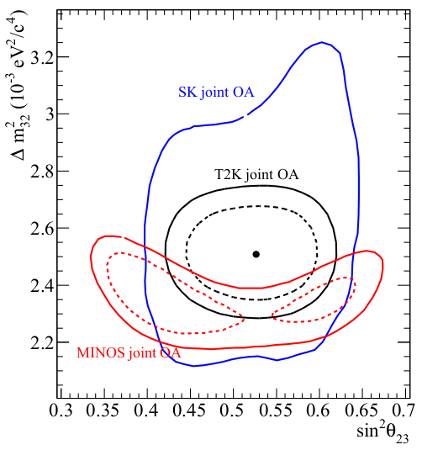
We report on measurements of neutrino oscillation using data from the T2K long-baseline neutrino experiment collected between 2010 and 2013. In an analysis of muon neutrino disappearance alone, we find the following estimates and 68% confidence intervals for the two possible mass hierarchies:
Normal Hierarchy: sin2θ23=0.514+0.055−0.056 and Δm232=(2.51±0.10)×10−3 eV2/c4
Inverted Hierarchy: sin2θ23=0.511±0.055 and Δm232=(2.48±0.10)×10−3 eV2/c4
The analysis accounts for multi-nucleon mechanisms in neutrino interactions which were found to introduce negligible bias.
We describe our first analyses that combine measurements of muon neutrino disappearance and electron neutrino appearance to estimate four oscillation parameters and the mass hierarchy. Frequentist and Bayesian intervals are presented for combinations of these parameters, with and without including recent reactor measurements. At 90% confidence level and including reactor measurements, we exclude the region:
δCP=[0.15,0.83]π for normal hierarchy and δCP=[−0.08,1.09]π for inverted hierarchy.
The T2K and reactor data weakly favor the normal hierarchy with a Bayes Factor of 2.2. The most probable values and 68% 1D credible intervals for the other oscillation parameters, when reactor data are included, are:
sin2θ23=0.528+0.055−0.038 and |Δm232|=(2.51±0.11)×10−3 eV2/c4.
Neutrino Oscillation Physics Potential of the T2K Experiment
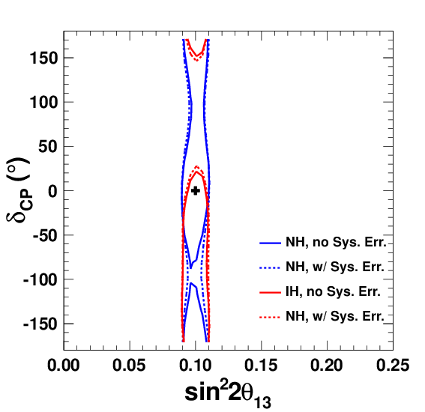
The observation of the recent electron neutrino appearance in a muon neutrino beam and the high-precision measurement of the mixing angle θ13 have led to a re-evaluation of the physics potential of the T2K long-baseline neutrino oscillation experiment. Sensitivities are explored for CP violation in neutrinos, non-maximal sin22θ23, the octant of θ23, and the mass hierarchy, in addition to the measurements of δCP, sin2θ23, and Δm232, for various combinations of neutrino-mode and anti-neutrino-mode data-taking.
With an exposure of 7.8×1021~protons-on-target, T2K can achieve 1-σ resolution of 0.050(0.054) on sin2θ23 and 0.040(0.045)×10−3 eV2 on Δm232 for 100%(50%) neutrino beam mode running assuming sin2θ23=0.5 and Δm232=2.4×10−3 eV2. T2K will have sensitivity to the CP-violating phase δCP at 90% C.L. or better over a significant range. For example, if sin22θ23 is maximal (i.e θ23=45°) the range is −115°<δCP<−60° for normal hierarchy and +50°<δCP<+130° for inverted hierarchy. When T2K data is combined with data from the NOνA experiment, the region of oscillation parameter space where there is sensitivity to observe a non-zero δCP is substantially increased compared to if each experiment is analyzed alone.
Precise Measurement of the Neutrino Mixing Parameter θ23 from Muon Neutrino Disappearance in an Off-axis Beam
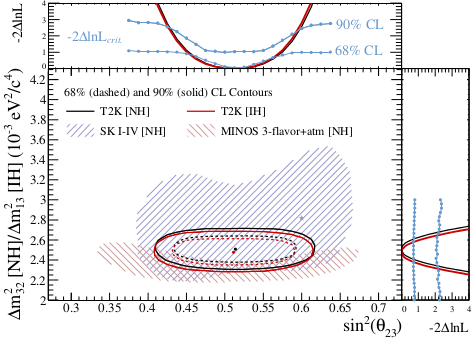
New data from the T2K neutrino oscillation experiment produce the most precise measurement of the neutrino mixing parameter θ23. Marginalizing over the values of other oscillation parameters yields sin2 (θ23) = 0.514 +0.055-0.056 (0.511 ± 0.055), assuming normal (inverted) mass hierarchy. The best-fit mass-squared splitting for normal hierarchy is Δm232 = 2.51 ± 0.10 × 10-3 eV2/c4 (inverted hierarchy: Δm213 = 2.48 ± 0.10 × 10-3 eV2/c4). Adding a model of multinucleon interactions that affect neutrino energy reconstruction is found to produce only small biases in neutrino oscillation parameter extraction at current levels of statistical uncertainty.
Observation of Electron Neutrino Appearance in a Muon Neutrino Beam
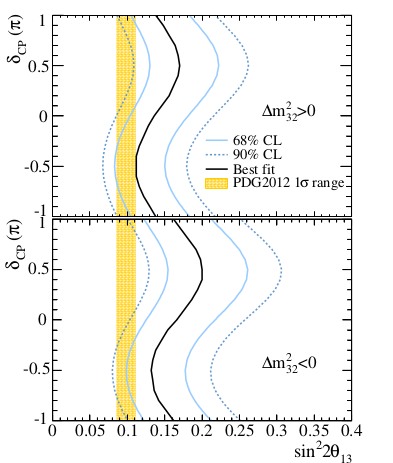
The T2K experiment has observed electron neutrino appearance in a muon neutrino beam produced 295 km from the Super-Kamiokande detector with a peak energy of 0.6 GeV. A total of 28 electron neutrino events were detected with an energy distribution consistent with an appearance signal, corresponding to a significance of 7.3σ when compared to 4.92 ± 0.55 expected background events. In the PMNS mixing model, the electron neutrino appearance signal depends on several parameters including three mixing angles θ12, θ23, θ13, a mass difference Δm232 and a CP violating phase δCP. In this neutrino oscillation scenario, assuming |Δm232|=2.4×10−3 eV2, sin2θ23=0.5, δCP=0, and Δm232>0 (Δm232<0), a best-fit value of sin22θ13 = 0.140+0.038−0.032 (0.170+0.045−0.037) is obtained.
Measurement of Neutrino Oscillation Parameters from Muon Neutrino Disappearance with an Off-axis Beam
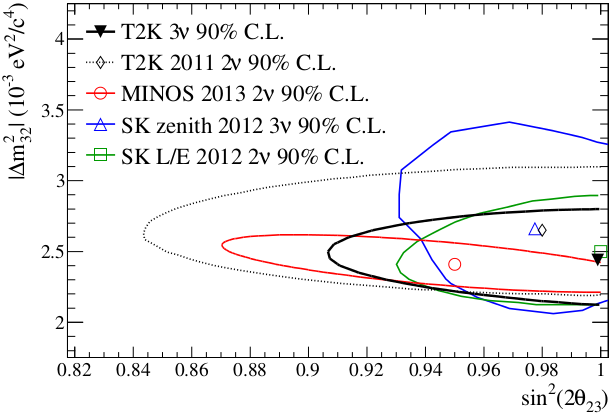
The T2K collaboration reports a precision measurement of muon neutrino disappearance with an off-axis neutrino beam with a peak energy of 0.6 GeV. Near detector measurements are used to constrain the neutrino flux and cross section parameters. The Super-Kamiokande far detector, which is 295 km downstream of the neutrino production target, collected data corresponding to 3.01 × 1020 protons on target. In the absence of neutrino oscillations, 205 ± 17 (syst.) events are expected to be detected and only 58 muon neutrino event candidates are observed. A fit to the neutrino rate and energy spectrum assuming three neutrino flavors, normal mass hierarchy and θ23≤ π/4 yields a best-fit mixing angle sin2(2θ23)=1.000 and mass splitting |Δ m232| =2.44 × 10-3 eV2/c4. If θ23≥ π/4 is assumed, the best-fit mixing angle changes to sin2(2θ23)=0.999 and the mass splitting remains unchanged.
Evidence of Electron Neutrino Appearance in a Muon Neutrino Beam
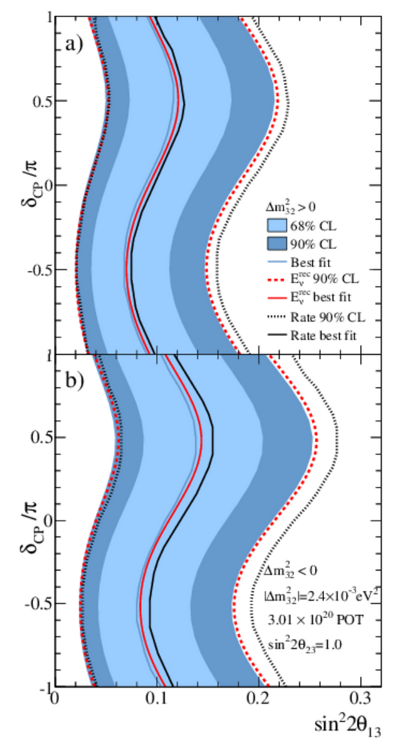
The T2K collaboration reports evidence for electron neutrino appearance at the atmospheric mass splitting, |Δm322|=2.4×10-3 eV2. An excess of electron neutrino interactions over background is observed from a muon neutrino beam with a peak energy of 0.6 GeV at the Super-Kamiokande (SK) detector 295 km from the beam’s origin. Signal and background predictions are constrained by data from near detectors located 280 m from the neutrino production target. We observe 11 electron neutrino candidate events at the SK detector when a background of 3.3±0.4(syst.) events is expected. The background-only hypothesis is rejected with a p-value of 0.0009 (3.1σ), and a fit assuming νμ→νe oscillations with sin2(2θ23)=1, δCP=0 and |Δm322|=2.4×10-3 eV2 yields sin2(2θ13)=0.088+0.049-0.039(stat.+syst.).
First Muon-Neutrino Disappearance Study with an Off-Axis Beam
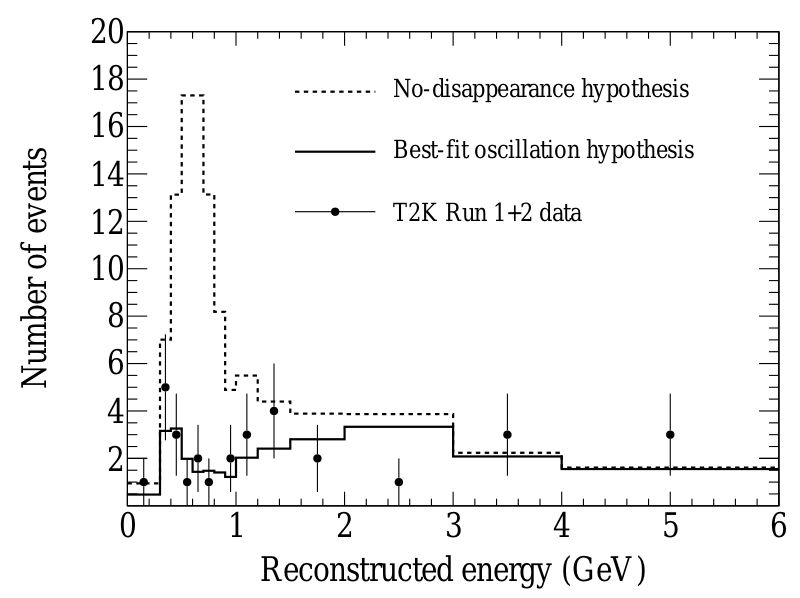
With data corresponding to 1.43×1020 protons on target, we observe 31 fully-contained single muon-like ring events in Super-Kamiokande, compared with an expectation of 104±14 (syst) events without neutrino oscillations. The best-fit point for two-flavor nu_mu -> nu_tau oscillations is sin2(2 θ23) = 0.98 and |Δm232| = 2.65×10-3 eV2. The boundary of the 90 % confidence region includes the points (sin2(2 θ23),|Δm232|) = (1.0, 3.1 10-3 eV2), (0.84, 2.65×10-3 eV2) and (1.0, 2.2×10-3 eV2).
Indication of Electron Neutrino Appearance from an Accelerator-produced Off-axis Muon Neutrino Beam
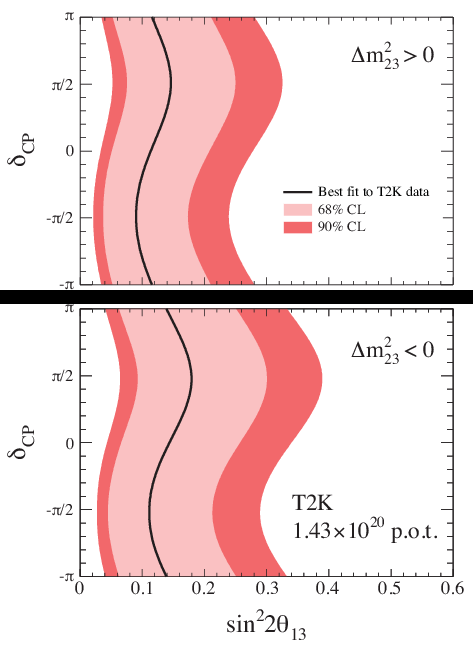
The T2K experiment observes indications of νμ → νe appearance in data accumulated with 1.43×1020 protons on target. Six events pass all selection criteria at the far detector. In a three-flavor neutrino oscillation scenario with Δm223 = 2.4×10-3 eV2, sin2(2θ23) = 1 and sin2(2θ13) = 0, the expected number of such events is 1.5±0.3(syst.).


